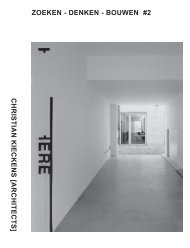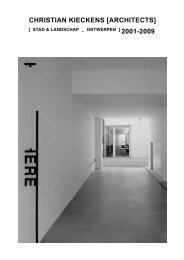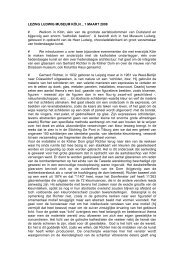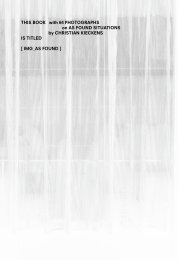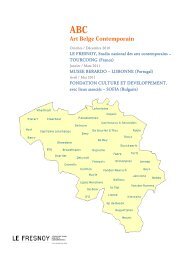adsl 2012 lectures - Christian Kieckens Architects
adsl 2012 lectures - Christian Kieckens Architects
adsl 2012 lectures - Christian Kieckens Architects
You also want an ePaper? Increase the reach of your titles
YUMPU automatically turns print PDFs into web optimized ePapers that Google loves.
Cino ZUCCHI<br />
Cino Zucchi was born in Milano in 1955; he graduated at M.I.T. in 1978 and at the Politecnico di<br />
Milano in 1979, where he is currently Chair Professor of Architectural and Urban Design. He has<br />
taught architecture at many international seminars and has been visiting professor at Syracuse<br />
University and at ETH in Zürich.<br />
Together with Cino Zucchi Architetti, he designed and realized many industrial, commercial,<br />
residential and public buildings, a number of projects for public spaces, master plans and renewals<br />
of industrial and historical areas. Major works of CZA include the urban design of the former<br />
Junghans factory site in Venice, the master plan for the Keski Pasila area in Helsinki, residential and<br />
office buildings for the former Alfa Romeo-Portello area in Milano, the new headquarters of Salewa<br />
in Bozen, Lavazza in Turin, and Group M in Assago, and the extension and renovation of the Turin<br />
National Car Museum which was recently awarded with the Inarch/Ance 2011 prize. The projects of<br />
the studio have been published in books and magazines worldwide.<br />
A city is (not) a tree<br />
Transforming contemporary urban environments<br />
The geological and biological metaphors recurring in contemporary<br />
urban theory seem to hide the fear we are not able to produce<br />
environments with the ‘second nature’ feeling of traditional cities,<br />
which today we can only reproduce as commercial caricatures.<br />
The landscape of the new world cannot be but a strange mixture<br />
of man-made and natural environments in a symbiotic relationship;<br />
we have to reconsider our design behaviours, ‘grafting’ new<br />
spaces on the existing ones rather than dreaming of a brave new<br />
world.<br />
Our city is not a tree, and for this reason we can understand it. The<br />
beauty of the city is multiple, fallacious, occasional; but when it<br />
occurs, it overcomes the one of nature, it comforts us in its absence<br />
of perfection.<br />
Photo left: CZA_San Donà<br />
Neighborhood Park, San Donà di Piave (Venice), 2006-2008<br />
Cino Zucchi Architetti with Gueltrini e Stignani Associati<br />
Photo right: CZA_Salewa<br />
Salewa Headquarters, Bozen, 2007- 2011<br />
Closed competition – First prize<br />
Cino Zucchi Architetti and Park Associati<br />
Objects and territories<br />
Objects and Territories’ is not a retrospective. It focuses on the<br />
necessity of authenticity in design and looks at the changing<br />
position of architecture and architects in the social order.<br />
Branzi’s theoretical thinking and his creations are still based on the<br />
demystification of modernist ideology. He considers that design<br />
and architecture always embrace material and immaterial aspects.<br />
His career illustrates not only his critical thinking, activism and<br />
intellectual engagement, but also his opposition to over-consumption<br />
and the empty system of stardom in architecture.<br />
The lecture is an introduction to the exhibition that consists on the<br />
one hand of written material, models and a film that look explicitly<br />
at architecture: ‘No Stop City’ (1968), the ‘New Chartres of Athens’<br />
(2010) etc. It also includes non-applied work in which Branzi<br />
confronts death. The various installations all carry the same<br />
fundamental critique: objects and architecture are not pure utility<br />
objects born out of technology and consumer marketing, but<br />
should provide an answer to man’s real contemporary needs.<br />
Left: Zwin project, Knokke, 1999 © Andrea Branzi<br />
Right: Philips site project, Eindhoven, 2000 © Andrea Branzi<br />
24 25<br />
Andrea BRANZI<br />
Andrea Branzi (Florence, 1938) is a designer, architect, theorist, lecturer, publisher and creator of<br />
exhibitions who is based in Milan. In his early years he played a leading part in the development<br />
of the radical Italian architecture scene that thoroughly reshaped design and architectural history<br />
as from the sixties. He was one of the founding members of the Archizoom group, which between<br />
1964 and 1974 organised numerous experimental activities in the form of manifestoes, installations<br />
and happenings. From the seventies onwards he concentrated on the more theoretical issues of<br />
the new Italian design. He published many articles on this subject in such periodicals as Casabella,<br />
Modo, Domus, Interni, L’Unita and Terrazo, and continues to do so today. As a lecturer and cofounder<br />
of the Domus Academy, in the eighties and nineties he had a powerful influence on several<br />
generations of designers. He has an impressive number of innovative ideas and creations to his<br />
name, and has been a regular presence at such international events as the Milan design triennale,<br />
the Venice architectural biennales and Documenta in Kassel for more than forty years.



